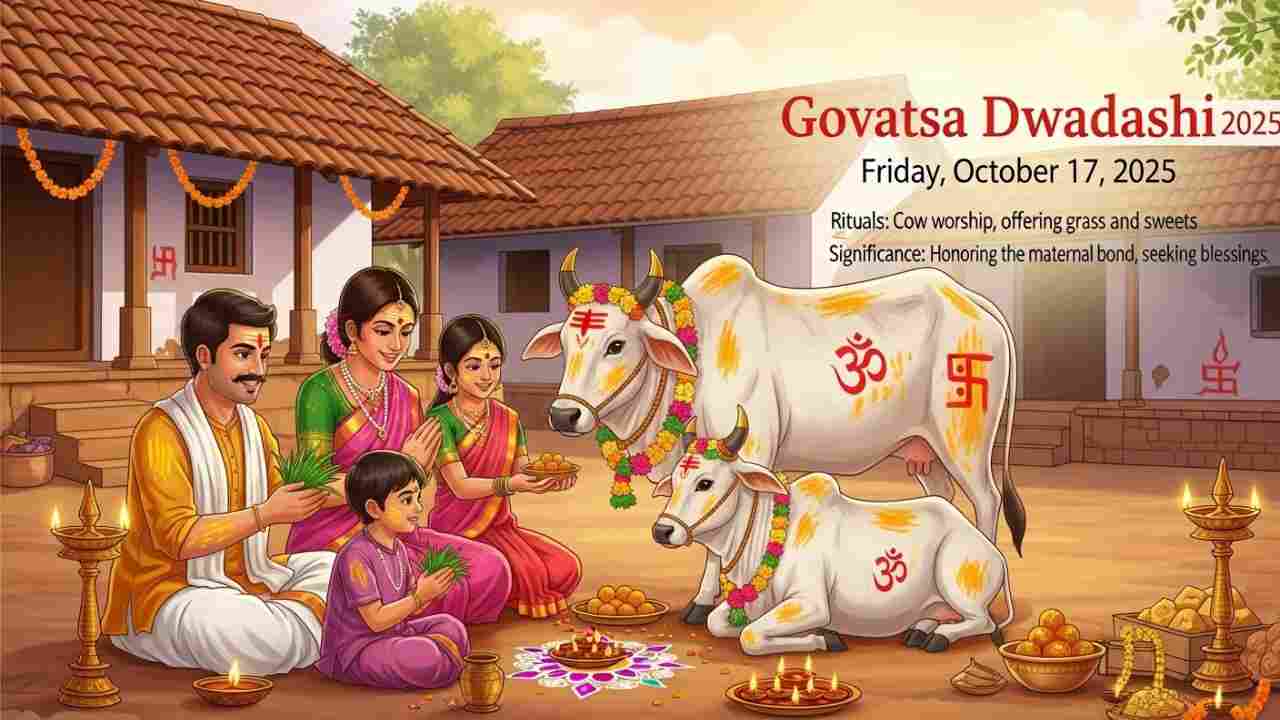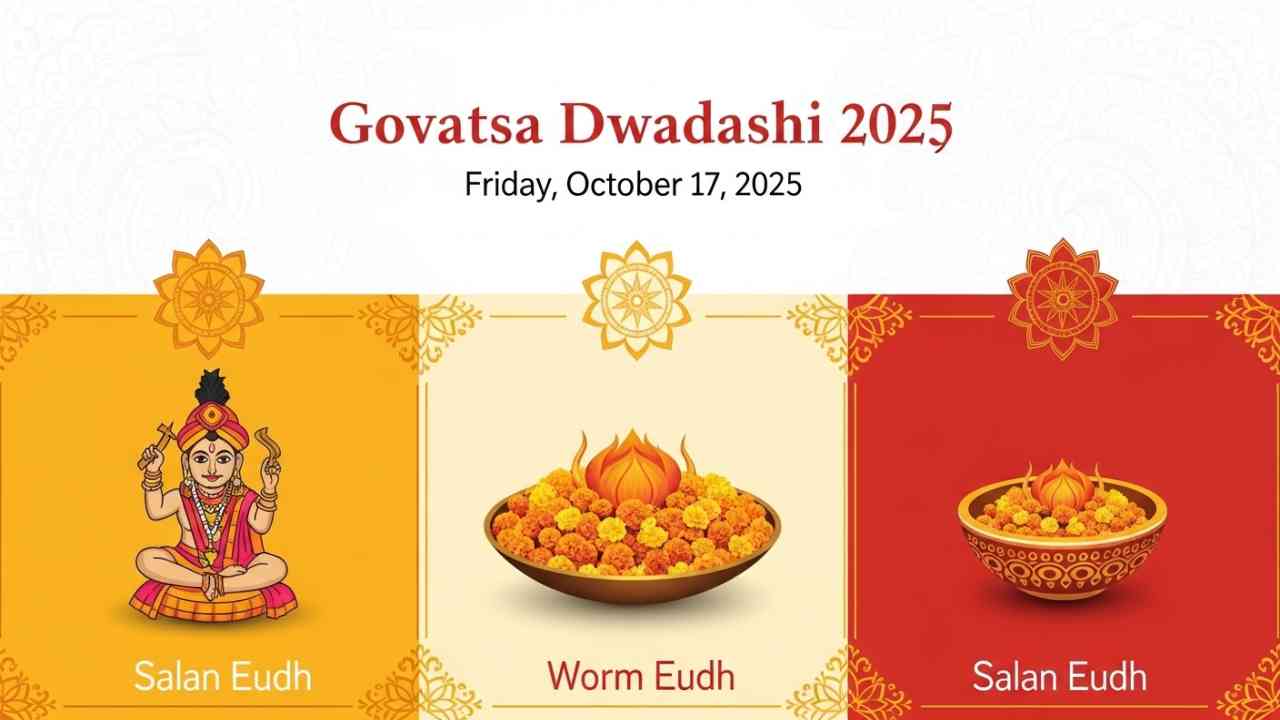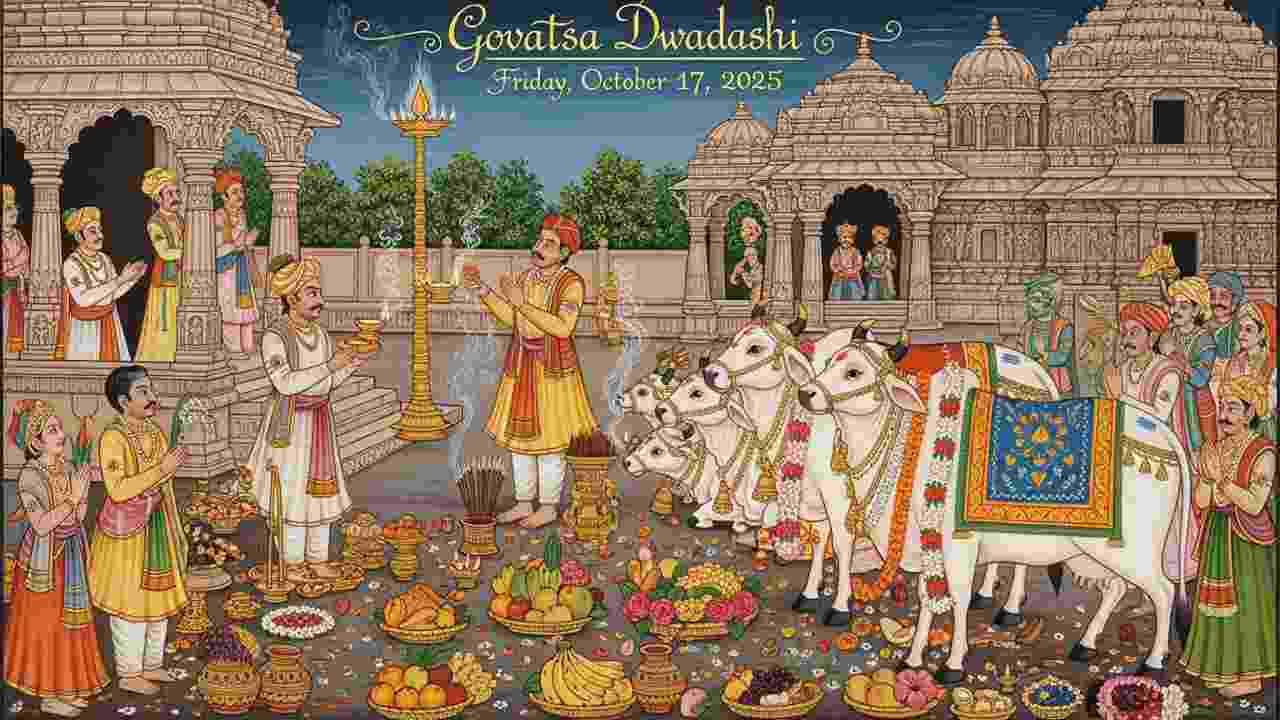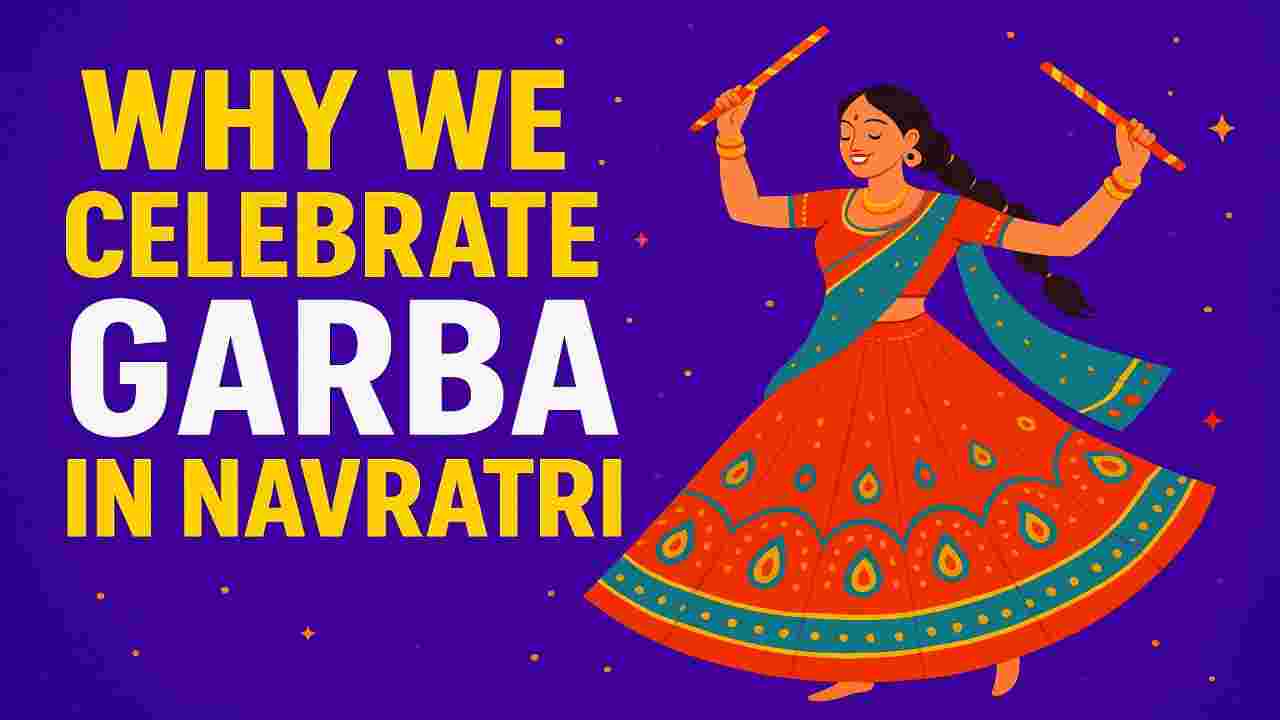
Have you ever seen a festival where cows are worshipped as mothers, not just animals? In India, this sacred tradition is celebrated as Govatsa Dwadashi, a festival dedicated to cows and calves, symbolizing nourishment, prosperity, and family welfare.
In this blog, we’ll explore when is Govatsa Dwadashi 2025, its cultural and spiritual significance, the rituals observed, and why this ancient practice continues to be meaningful even in modern times.
When is Govatsa Dwadashi 2025?
The first question devotees ask every year is: When is Govatsa Dwadashi 2025?
In 2025, Govatsa Dwadashi will be celebrated on Friday, 17th October 2025.
- Tithi: Dwadashi (12th day) of Krishna Paksha in the month of Kartik, according to the Hindu lunar calendar.
- Festival Importance: It marks the beginning of Diwali festivities in some regions, especially Maharashtra.
On this day, married women observe fasts and perform rituals to invoke blessings for family welfare, prosperity, and the well-being of children.
The Meaning of Govatsa Dwadashi
The word Govatsa comes from “Go” (cow) and “Vatsa” (calf), while “Dwadashi” means the twelfth day of the lunar fortnight. Thus, Govatsa Dwadashi is a day dedicated to worshipping cows and their calves.
Why cows?
- In Hindu tradition, the cow is considered “Gau Mata” (Mother Cow), a symbol of motherhood and nurturing.
- Cows provide milk, which is seen as the ultimate nourishment for life.
- Scriptures equate the cow with goddess Lakshmi, the harbinger of wealth and prosperity.
This is why Govatsa Dwadashi is celebrated as an auspicious day of gratitude, devotion, and family blessings.
Mythological Legends Behind Govatsa Dwadashi

Several fascinating legends give meaning to Govatsa Dwadashi:
1. Nandini, the Divine Cow
According to Hindu mythology, Nandini was a wish-fulfilling cow in Sage Vashishta’s ashram. She could provide anything desired, symbolizing abundance and prosperity. Worship of cows on Govatsa Dwadashi is linked to honoring Nandini’s divine blessings.
2. Motherhood and Nourishment
The cow represents the nurturing qualities of a mother. By worshipping cows and calves, devotees honor the bond between mother and child, seeking the welfare of their own children.
3. Association with Lord Krishna
In some regions, Govatsa Dwadashi is connected to Krishna’s love for cows. Known as Govinda or Gopala (protector of cows), Krishna is remembered during this festival.
Rituals of Govatsa Dwadashi 2025
The rituals of Govatsa Dwadashi 2025 vary across regions but share common themes of worship, fasting, and devotion.
1. Fasting by Married Women
- Women observe a day-long fast (known as Govatsa Vrat) for the prosperity of their family.
- They abstain from milk, curd, ghee, and other cow-related products as a mark of respect.
2. Worship of Cows and Calves
- Cows are bathed, decorated with garlands, and their horns painted in bright colors.
- Rituals involve feeding cows with special offerings like wheat, gram, and sweets.
- In households without live cows, symbolic clay or metal idols of a cow and calf are worshipped.
3. Puja Rituals
- Devotees light lamps and offer kumkum, turmeric, and flowers.
- Women recite vrat katha (legendary stories) related to Govatsa Dwadashi.
- Special prayers are offered for children’s longevity and well-being.
4. Charity (Dan)
- Feeding cows, calves, and even stray animals is considered highly meritorious.
- Some families also donate food and clothes to the needy.
Govatsa Dwadashi as the Beginning of Diwali
In Maharashtra and some other regions, Govatsa Dwadashi marks the start of Diwali festivities.
- People decorate their homes, light lamps, and prepare for the five-day Diwali celebration.
- It is seen as an auspicious day that sets the tone for prosperity and light.
Regional Variations of Govatsa Dwadashi 2025

Though celebrated widely, Govatsa Dwadashi takes different forms across India:
- Maharashtra: Known as Vasu Baras, it is celebrated with grand rituals. Women especially perform fasting and cow worship.
- North India (Uttar Pradesh, Bihar): Families worship symbolic idols of cow and calf at home.
- Gujarat & Rajasthan: Seen as a day of prosperity rituals, with offerings made to cows and donations given to Brahmins.
- South India: While not as prominent, some regions link the festival with Krishna worship.
Spiritual and Cultural Significance
Why does Govatsa Dwadashi hold such deep meaning?
- Symbol of Motherhood: Just as a cow nourishes its calf, the festival highlights the importance of a mother’s role in nurturing children.
- Prayer for Children’s Welfare: Married women fast and pray for the long, healthy lives of their children.
- Prosperity & Family Harmony: Worshipping cows is believed to invite blessings of wealth, harmony, and prosperity.
- Respect for Nature & Animals: The day reminds us of the ecological and spiritual importance of animals in human life.
Preparing for Govatsa Dwadashi 2025

If you’re planning to observe Govatsa Dwadashi 2025, here’s a quick guide:
- Mark the Date: Friday, 17th October 2025.
- Prepare Puja Items: Clay/metal cow idols (if cows are not available), flowers, kumkum, turmeric, wheat, gram, sweets, and diya.
- Plan Charity: Feed cows or stray animals, and consider donating to those in need.
- Family Involvement: Encourage children to take part in rituals to understand cultural values.
Modern-Day Relevance of Govatsa Dwadashi
Even today, Govatsa Dwadashi 2025 is more than just a ritual, it carries values for modern living:
- Gratitude to Nature: Reminds us to respect the animals and environment that sustain us.
- Family Bonds: Strengthens the role of family prayers and collective rituals.
- Women’s Devotion: Highlights women’s role in nurturing traditions and ensuring family prosperity.
- Cultural Identity: Keeps alive the rich spiritual practices of India amidst urban lifestyles.
So, when is Govatsa Dwadashi 2025?
It will be celebrated on Friday, 17th October 2025. On this sacred day, married women fast and perform rituals for the welfare of their families, while devotees worship cows and calves as symbols of nourishment, prosperity, and motherhood.
Govatsa Dwadashi 2025 is not just about rituals. It is a reminder of gratitude, respect for nature, and the eternal bond between mother and child.
May this Govatsa Dwadashi bring peace, health, and prosperity to your home.
Want to explore more Hindu festival dates and their significance? Check out our other mythology blogs.
FAQs
Q1. When is Govatsa Dwadashi 2025 celebrated?
Govatsa Dwadashi 2025 will be observed on Friday, 17th October 2025. It marks the beginning of Diwali festivities in some regions of India.
Q2. Why is Govatsa Dwadashi celebrated?
The festival is celebrated to honor and worship cows, symbolizing motherhood, nourishment, and prosperity. It also seeks blessings for family welfare and children’s well-being.
Q3. Who mainly observes Govatsa Dwadashi?
Married women especially observe fasts and rituals on Govatsa Dwadashi, praying for their family’s prosperity and the long life of their children.
Q4. What rituals are performed on Govatsa Dwadashi 2025?
On this day, cows and calves are bathed, decorated with flowers, and worshipped. Women observe fasting, prepare special meals, and perform puja to invoke blessings.
Q5. Is Govatsa Dwadashi known by other names?
Yes, Govatsa Dwadashi is also known as Nandini Vrat in some regions of India. In Maharashtra, it is observed with great devotion as part of the Diwali festivities.

